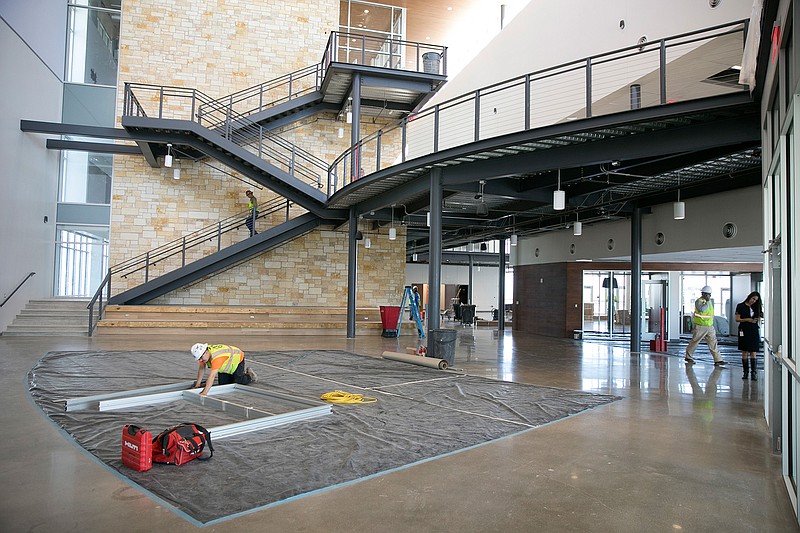MANOR, Texas-There is no stopping the growth in Manor, one of the more affordable suburbs of Austin. But the school district is now putting its final touches on a new secondary school building that officials say will make room for more students without losing a close-knit feel.
The Austin American-Statesman reports the district's plan is for the new campus, Manor Senior High School, to be the home base for juniors and seniors, leaving the old Manor High School primarily for freshmen and sophomores.
The two-campus high school is also an attempt to better engage students and give them more ownership of their studies. Like other recently constructed high schools, the new Manor Senior High has the look and feel of a small college campus: open and collaborative work spaces, large windows and natural light, and charging stations for cellphones and laptops.
Similar in shape to a boomerang, construction is nearly complete on the 215,000-square-foot, 1,200-student capacity school that will initially open with 900 juniors and seniors in August. The $48 million campus is being built with 2014 bond money, initially earmarked for renovations to the original Manor High School. Instead, the district put that money toward new space to keep the high school a more manageable size while the number of students continues to climb.
"Splitting those students out in the smaller learning environments, I think we're going to see a better return on investment," said Superintendent Royce Avery, who took the helm in 2016. "When teachers have more opportunity to engage smaller groups of kids, it has a more profound effect of what kids are giving them and what they are giving the kids."
The 9,100-student Manor school district is expected to grow by an additional 2,600 students in the next five years, and add nearly 5,700 more over the next decade, according to demographer projections. Manor is one of the few remaining areas of Central Texas with affordable housing, with an average home market value of $195,177 in 2017.
"It's one of the last few places close in (to Austin) where you can afford that American dream," said developer Pete Dwyer, who began building in Manor 17 years ago.
Dwyer said the area is quickly drawing millennials and young families with school-age children who hear about the district's high-tech campuses, including Manor New Tech High School, which was visited by President Barack Obama in 2014, as well as newer elementary schools and a middle school with the same focus.
New home construction is accelerating, Dwyer said: "It's growth like I've never seen before."
The Manor Senior High campus is in the far northeast portion of the district, bounded by some nearby farms and undeveloped land. The school site already houses the Manor Athletic Complex, which cut the cost of building the campus since utilities already were in place.
The original Manor High, which received its own improvements, already is at capacity, with 1,762 students.
The new Manor Senior High campus largely will offer upperclassmen their core classes. But upperclassmen who are taking career and technical education courses at the original Manor High campus, as well as Manor High students taking advanced level courses or who are on varsity athletics, will be bused back and forth between the two schools. It is 4 miles from one campus to another. At least one bus will ferry students between periods, and district officials said the buses can make the trek during the 10-minute period between classes so students won't miss anything.
Other Texas school districts, including Plano and Southlake Carroll, have opened two-campus high schools. A few other Central Texas suburbs, such as Lake Travis, have been reluctant to open a second main high school and have embraced similar concepts like placing an annex on the same property to accommodate more students.
The Manor Senior High campus will have beefed up career and technology work spaces. In the cosmetology department, for example, there will be a waiting room for community members signed up to get student haircuts, pedicures and facials. Students in the veterinarian medical program, under supervision, will work with animals and provide wellness checkups for pets brought in by community members.
The school will feature a makerspace, with some hardbound books like a traditional library, but also collaborative workspaces and high-tech tools like a 3-D printer; a technology room where students can borrow chromebooks or iPads; small conference rooms similar to those found in college libraries; a commercial kitchen with the feel of a bistro for culinary arts students; and a student-run coffee bar.
The campus also will offer more advanced and dual credit courses, and it will have a mock courtroom that includes a judge and jury box for students in law and public service programs.
"My vision as principal is to always give students an experience of learning that they enjoy, moving away from our industrial focus of 'you're learning what we're telling you to learn' and instead, kids enjoying what their learning and owning their learning," Principal Debra Aceves said.
Aceves said she hopes the focus on the smaller, student-centered environment, with upperclassmen in one location, will also help boost the high school's four-year federal graduation rate, which was about 93 percent in 2016, and ensure every student graduates.
"It might not happen in the first year, but that's definitely in a two- to three-year plan that we hit a 100 percent graduation rate," Aceves said. "The focus on 11th- and 12th-graders starting off at about 900 will definitely make that a doable goal."

